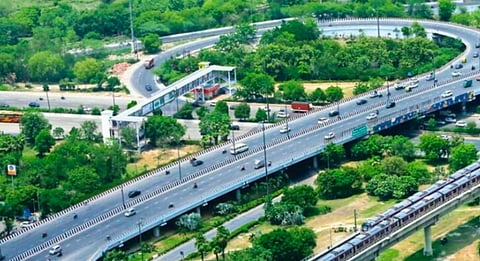NCR Regional Plan 2041 Will Dilute Conservation Norms, Experts Warn
The regional plan for the National Capital Region (NCR) is currently in its final leg of finalisation, awaiting approvals from the neighbouring states. The plan, a routine exercise in overhauling the development of the region, is facing flak over some provisions in its current draft. The provisions make construction easier at the cost of conservation, essentially making it easier for builders to override them.
The NCR Planning Board (NCRPB) has prepared a draft Regional Plan 2041(RP-2041), to replace the existing Regional Plan 2021, and circulated it for comment to the member states. The planning board, hosted by Union Housing and Urban Affairs Minister Hardeep S. Puri, held its 40th meeting this week. While the other states have submitted their suggestions, Haryana has sought more time, leading to the deferment of the plan by another month.
The splitting of the National Conservative Zone (NCZ) in the draft plan has become a major contention. The plan proposes that the NCRPB split the NCZs into two categories, "forests" and "green cover", which is likely to ease the current norms that restrict non-forest activities in such zones. Areas such as Aravalis, river beds, lakes and water recharging spaces are currently considered as NCZs.
This distinction would imply that conservation of areas termed as green covers will not be mandatory, thereby, easing development and construction work for giant corporations. Activists in Haryana have specifically flagged that this could impact the conservation of the Aravalli ranges which are not designated forests, however, were given protection under the previous plans.
Activists explain that the draft Regional Plan-2041 for the National Capital Region has dropped or amended several environmental safeguards present in the current plan (Regional Plan-2021). They warn that this could possibly result in long-term disastrous implications for the NCZs in the region.
Speaking to NewsClick, Chetan Agarwal, a Forest and Environmental Services Analyst, explained, "The plan is at a stage where states have been asked to give feedback, post which the plan will be available for public comments. Haryana has asked for an extension on its comments. There were several progressive provisions in the earlier plan for the safeguarding of the environment that have been done away with. This is a statutory plan, whatever is "shall" is mandatory, whatever is "may" is optional. In the earlier plan, the limit on construction was 0.5%. It would be divided into forests and other zones in the current plan. Now, the green area conservation becomes a guideline as they have removed the 'mandatory' provision."
Under the current plan— "0.5% to the total area under NCZ is allowed for related compatible development, either at one place or at multiple locations, subject to other approvals, Acts of different States…".
Activists warn that making the 0.5% limit transferable and the inclusion of an open-ended category of "Compatible Development" could lead to State governments using the entire quota of 0.5% in one or a few concentrated locations, effectively breaching the existing limit of 0.5% per plot.
Moreover, many safeguards from the previous plan have been deleted. These include the provision that the Aravalli ridge, sanctuaries and other ecologically sensitive areas be conserved with utmost care and afforested with suitable species (pg 153). The provision to protect and maintain water bodies and the areas under water-bodies, ox-bow lakes and paleo-channels and their surrounding areas, as shown in the Groundwater Rechargeable Areas, also remains deleted.
In the previous plan construction in the flood-prone areas/river beds/banks was not permitted. The deleted section includes the provision on the Flood Protection Plan, which was to be prepared by the concerned State Governments/agencies.
Speaking to NewsClick, activist Bhavreen Kandhari, a part of the group called Warrior Moms Demanding Clean Air and Environment, said, "These kinds of drafts & policies are disastrous, especially for NCR type of locations which fall in the most polluted regions of the world…. While on international forums, we are talking about Climate Change & conserving biodiversity, our actions seem to be way apart, with the government hell-bent on cutting down the last leg of forests and destroying the green cover."
NCR Regional Plan-2041 also proposes high-rise development and five to eight new greenfield townships. The draft had been sent to the NCR constituent States, Delhi, Uttar Pradesh, Haryana and Rajasthan, in January and comments from all of them had been received.
NewsClick reached out to Delhi and Haryana government officials with questions over the plan, however, did not receive any response.
First published by Newsclick.

